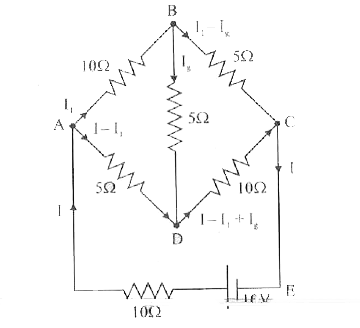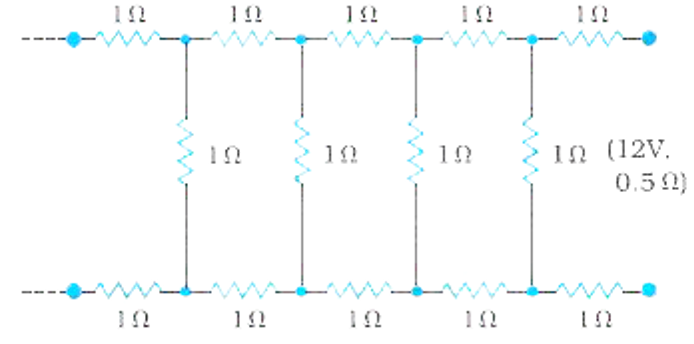SOLUTION TO EXERCISES FROM NCERT TEXT from NEW JYOTHI PHYSICS (TAMIL ENGLISH) CURRENT ELECTRICITY for Class 12
| Class 12 | PHYSICS |
| Chapter | CURRENT ELECTRICITY |
| NEW JYOTHI PHYSICS (TAMIL ENGLISH) | SOLUTION TO EXERCISES FROM NCERT TEXT |
| Medium | English |
| Academic Year | 2023-2024 |
Question 4
a.Three resistors 2Ω,4Ω and 5Ω are combined in parallel. What is the total resis- tance of the combination?
b. If the combination is connected to a battery of emf 20 V and negligible internal resistance, determine the current through each resistor and the total current drawn from the battery.View SolutionQuestion 8
A heating element using nichrome connected to a 230V supply draws an initial current of 3.2 A which settles after a few seconds to steady value of 2.8 A. What is the steady temperature of the heating element if room temperature is 27.0∘C? Temperature coefficient of resistance of nichrome averaged over the temperature range involved is1.70×10−4View SolutionQuestion 10
a. In a metre bridge the balance point is found to be at 39.5 cm from the end A, when the resistor Y is of 12.5Ω. Determine the resistance of X. Why are the connections between resistors in a Wheatstone or meter bridge made of thick copper strips?
b. Determine the balance point of the bridge if X and Y are interchanged.
c. What happens if the galvanometer and cell are interchanged at the balance point of the bridge? Would the galvanometer show any current? View Solution
View SolutionQuestion 14
The earth's surface has a negative surface charge of 10−9Cm−2. The potential difference of 400 kV between the top of the atmosphere and the surface results (due to the low conductivity of the lower atmosphere) in a current of only 1800 A over the entire globe. If there were no mechanism of sustaining atmospheric electric field, how much time (roughly) would be required to neutralise the earth's surface? (This never happens in practice because there is a mechanism to replenish electric charges, namely the continal understorms and lihgtningin curent parts of the globe. (Radiu of each 6.37×106m) View SolutionQuestion 15
a. Six lead-acid type of secondary cells each of emf 2.0 V and internal resistance 0.015Ω are joined in series to provide a supply to a resistance of 8.5Ω. What are the current drawn from the supply and its terminal voltage?
b. A secondary cell after long use has an emg of 1.9 V and a large internal resistance of 380Ω. What maximum current can be drawn from the cell? Could the cell drive the starting motor of a car?View SolutionQuestion 16
Two wires of equal length, one of aluminium and the other of copper have the same resistance. Which of the two wires is lighter? Hence explain why aluminium wires are preferred for overhead power cables. (P_(Al) = 2.63xx 10^(-8)Omegam, P_(au) = 1.72 10^(-8)Omegam, Relative density of Al = 2.7 and that of Cu = 8.9.)View SolutionQuestion 18
Answer the following questions.
a. A steady current flows in a metallic conductor of non-uniform cross-section. Which of these quantities is constant along the conductor current, current density, electric field, drift speed?
b. Is Ohm's law universally applicable for all conducting elements? If not, give examples of elements which do not obey Ohm's law.
c. A low voltage supply from which one needs high currents must have very low internal resistance. Why?
d. A high tension (HT) supply of, say, 6 kV must have a very large internal resistance. Why?View SolutionQuestion 19
Choose the correct alternative:
a. Alloys of metals usually have (greater/less) resistivity than that of their constituent metals.
b. Alloys usually have much (lower/higher) temperature coefficient of resistance than pure metals.
c. The resistivity of the alloy manganin is nearly independent of increases rapidly with increase of temperature.
d. The resistivity of a typical insulator (e.g., amber) is greater than that of a metal by a factor of the order of (1022/103). View SolutionQuestion 20
a. Given n resistors each of resistance R. How will you combine them to get the (1) maximum (ii) minimum effective resistance? What is the ratio of the maximum to minimum effective resistance?
b. Given the resistances of 1Ω,2Ω,3Ω.. How will you combine them to get an equivalent resistance of (i) (11/3) Ω(ii) (11/5)Ω, (iii) 6Ω, (iv) (6/11) Ω?
c. Determine the equivalent resistance of networks shown in the figure.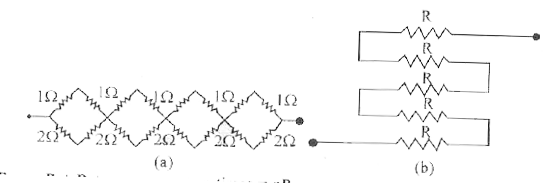 View Solution
View SolutionQuestion 22
Figure shows a potentiometer with a cell of 2.0 V and internal resistance 0.402 main taining a potential drop across the resistor wire AB. A standard cell which maintains a constant emf of 1.02 V (for very moderate currents upto a few mA) gives a balance point at 67.3 cm length of the wire. To ensure very low currents drawn from the standard cell, a very high resistance of 600 k Ω is put in series with it, which is shorted close to the bal- ance point. The standard cell is then replaced by a cell of unknown emf and the balance point is found similarly, turns out to be at 82.3 cm length of the wire.
a. What is the value &?
b. What purpose does the high resistance of 600 kΩ have?
c. Is the balance point affected by this high 600 kg resistance?
d. Is the balance point affected by the internal resistance of the driver cell?
e. Would the method work in the above situation if the driver cell of the potentiometer had an emf of 1.0V instead of 2.0V?f. Would the circuit work well for determining an extremely small emf, say of the order of a few mV (such as the typical emf of a thermo-couple)? If not, how will you modify the circuit? View Solution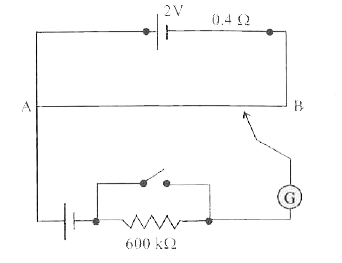
Question 23
Figure shows a potentiometer circuit for comparison of two resistances. The balance point with a standard resistor R = 10.0Ωis found to be 58.3 cm, while that with the unknown resistance X is 68.5 cm. Determine the value of X. What might you do if you failed to find a balance point with the given cell of emf ε ?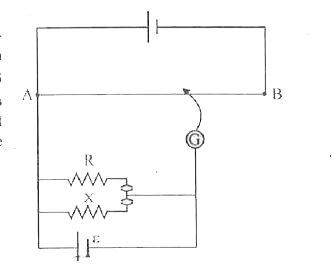 View Solution
View SolutionQuestion 24
Figure shows a 2.0 V potentiometer used for the determination of internal resistance of a 1.5 V cell. The balance point of the cell in open circuit is 76.3 cm. When a resistor of 9.5Ω is used in the external circuit of the cell, the balance point shifts to 64.8 cm length of the potentiometer wire. Determine the internal resistance of the cell
 View Solution
View Solution

